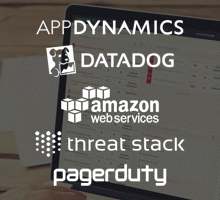The Mainstreaming of DevOps
Here at PagerDuty, we spend a lot of time thinking about how we can help the DevOps community and IT professionals succeed. We’re particularly interested in the “hows and whys” of evolving DevOps practices, how to deliver value to our practitioners, and how to better serve the community that places such high trust in PagerDuty.
With that in mind, we recently hosted a webinar featuring industry leaders, asking them to share up-and-coming practices as well as their predictions about the future of DevOps. We incorporated perspectives from the world of applications and security monitoring, as well as APM, and gained insights on digital operations management. The group included:
 Ilan Rabinovich, Director of Technical Community at Datadog
Ilan Rabinovich, Director of Technical Community at Datadog- Chris Gervais, VP of Engineering at Threat Stack
- John Rakowski, Director of Product Marketing at AppDynamics
- Arup Chakrabarti, Director of Engineering at PagerDuty
We addressed a number of questions about the future of DevOps, including, “Is DevOps finally mainstream?” and “Can enterprise organizations adopt DevOps practices?” Our panelists had a lot to share, and we’ve captured the highlights below.
Is DevOps finally mainstream?
Each speaker shared their thoughts on the idea of DevOps finally becoming mainstream:
Ilan Rabinovich of Datadog commented that the industry has achieved “peak usage” of the DevOps term, citing a proliferation of tools, conferences and an overall environment of marketing spin. He also points out that not everyone is using the DevOps term in the same way, and that true DevOps is evidenced by the “CAMS” definition: Culture, Automation, Metrics and Sharing as pillars of the journey.
Chris Gervais of Threat Stack agreed that the term DevOps has certainly gone mainstream, even if adoption might lag. He suggests that for many organizations and certain kinds of companies, DevOps is built into the fabric of what they do. In particular, startups and firms that create SaaS products, leverage DevOps as a sort of foundational, native capability and the DevOps approach is really nothing new, and part of this type of company’s “origin story.” Companies that want to move fast and use infrastructure as code have embraced the availability of DevOps tools, as well as the community. He even joked that if a recent TechCruncharticle declared DevOps to be dead, it must now be mainstream!
John Rakowski of AppDynamics views the mainstreaming of DevOps as a kind of a “Yes and No” proposition. He agreed with our other panelists that a person can’t go anywhere without hearing about DevOps, and noted Gartner’s 2015 prediction about DevOps becoming a mainstream strategy by 2016. While reality may not be so closely aligned, Rakowski feels that interest is certainly mainstream, but an ongoing struggle and debate around DevOps definitions persists, especially across different industries and organizations. He sees a meaningful difference between enterprise DevOps and the DevOps of startups, with enterprises establishing separate teams to reap DevOps benefits.
Arup Chakrabarti says that DevOps “is just the way it is” for smaller companies. For established companies, DevOps isn’t the norm, but that many enterprises are on an evolutionary path. He noted that some banks and telcos — known for being slow and cumbersome — have embraced DevOps in pockets and have done a fantastic job. Yet he suggests that the DevOps community needs to do more work to become mainstream within enterprises.
Can enterprise organizations adopt DevOps practices?
On the question of the enterprise adopting DevOps, Rabinovich feels that adoption is less about technology than it is about culture and organizational alignment. In the enterprise, distinct IT teams, assigned to business units or projects, can create silos, which foster infighting that can be addressed by sharing and aligning goals and business objectives.
“The more successful DevOps orgs have tackled culture and sharing first, then the tools and the metrics to accelerate the journey,” commented Rabinovich. He feels that the market has been selling tools, events and other solutions to attack the technology piece, but that culture and sharing should be an area of greater mainstream focus. Buying a suite of DevOps tools is one thing, but Ilan suggests that if teams aren’t building a collaborative culture, there will be little progress if data can be shared and that learning can be difficult. In his view, leveraging the CAMS model and working together to identify common goals is a key path to organizational success because it drives alignment and efficiency, and creates ways to track and share the success that leads to securing additional resources.
Threat Stack’s Gervais addressed enterprise adoption via a question from the audience, asking if DevOps was “being pushed from the top down or from the bottom up.” Gervais suggests that it typically isn’t a case of CIO saying “ready set go” on DevOps and that instead, it can be more of a “middle out” process. Which is to say that DevOps grows not from just a subset of the IT team, but typically results when a few like-minded individuals get together to focus on a business problem. Once positioned around the business problem, the team can benefit from experimenting with and testing the DevOps model, as well as to establish metrics that may be out of the traditional enterprise project plan. Gervais suggests that if DevOps originates in traditional IT or PMO organizations, it can inherently be limited in its ability to get started.
From Rakowski’s perspective, the implementation of DevOps across the enterprise is something he considers to be an “ultimate” question, seeing it more along the lines of “how is your DevOps adoption going across the enterprise?” He points out that software is at the heart of customer interactions and employee productivity, and that applications drive business outcomes. As such, the reality is that faster releases are mandatory because technology has become the number one driver of business performance. Rakowski states implementing DevOps isn’t a choice for the enterprise, and is, “something that IT must do to serve users and drive value to the business.”
Chakrabarti from PagerDuty suggests that adoption of DevOps is driven by culture, sharing, and alignment — three things he sees as the biggest challenges encountered by enterprises. Because Ops teams are focused on stability, and Development teams are focused on innovation and changes, they can fundamentally be at odds, and disparate groups create silos within organizations. As a result, he sees a strong need to create alignment through shared goals focused on business success, which balance site reliability and innovation.
Marketplace noise aside, our panelists seem to agree that DevOps is going mainstream and moving into the enterprise in 2017 and beyond! Important factors that drive adoption, including sharing and cultural change, are foundational elements of any DevOps initiative and alignment tends to equal success.
In our next installment of this blog series, we’ll explore additional key questions addressed, including: “Will central operations teams move closer to the application codebase?” and “Does security become a part of the DevOps operational model?”
In the meantime, be sure to check out the entire 2017 Predictions and Trends in DevOps webinar on BrightTalk!


